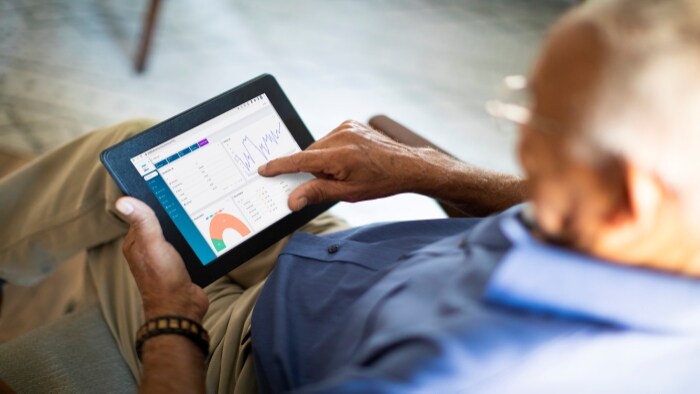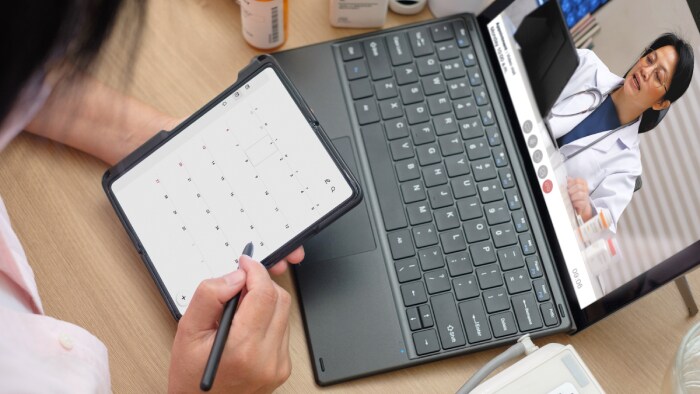The digital innovation wave is coming to the Asia Pacific Region
Sep 15, 2022 - Reading time 5-7 minutes
Virtual care and wearables are paving the way, but where do hospitals stand - and is the workforce ready?
Like many sectors, healthcare has been undergoing a period of rapid transformation. Advances in data and technology, new consumer needs, shifting demographics and the pandemic have meant that the world is turning to digital solutions and remote care now more than ever. Healthcare providers are assessing the role of options such as wearables, digital diagnostics, digital therapies, remote monitoring and telemedicine. Digital health is on the rise, and it seems that much of the Asia Pacific Region may be ready to embrace it - the value of digital health in Asia was $37 billion in 2020, and is estimated to reach $100 billion by 2025. [1] With this recent push to accelerate greater integration of technology into health, it is crucial to understand the future role of physical hospitals in the broader healthcare ecosystem.

A virtual revolution?
Asia seems keen on digital technology. In a 2019 survey, 78% of respondents from Asian countries said they were willing to use digital healthcare, compared with 66% globally [2], so it was not surprising that when the pandemic hit telemedicine apps in many markets saw enormous spikes in demand. Health technology companies headquartered in the region and offering this service saw the number of active users rise substantially in March 2020 compared to 2019 [3,4]. The pandemic also saw many markets establish “virtual hospital wards”, a hospitalisation-at-home system where wearable devices were used to monitor patients’ vital signs (e.g. blood oxygen levels, temperature and pulse), and telehealth was used to oversee therapy. At Singapore’s National University Health System (NUHS), these virtual wards saved patients ill with covid-19 more than five thousand overnight stays in the hospital [5], therefore bringing in huge cost-savings. “I think covid actually helped a lot in that change management, for people to be more open to remote delivery of services in general,” says Benedict Tan, Group Chief Digital Strategy Officer & Chief Data Officer for Singapore Health Services. “I think the challenge now is how to keep up with this momentum - we may have to re-examine the whole end-to-end experience, improve it, enhance it, make it seamless, and make it much easier for doctors to engage and continue with virtual and remote care.”
I think the challenge now is how to keep up with this momentum - we may have to re-examine the whole end-to-end experience, improve it, enhance it, make it seamless, and make it much easier for doctors to engage and continue with virtual and remote care.”
Benedict Tan
Group Chief Digital Strategy Officer & Chief Data Officer for Singapore Health Services
Some health systems have started to incorporate a hybrid model, bringing together the best of telehealth and in-person treatment, to try to deliver the same clinical outcomes with a better patient and staff experience. This is being implemented in Indonesia for example, according to Dr Ben Widaja, President Director of Mandaya Hospital Group in Jakarta. “We have our own mobile application where patients can book their appointment and have a tele-consultation. But we also give the opportunity for patients to speak with our nurses or our administration staff after their consultation to really answer their questions or address any worries, to provide that personalised care even if they are not within the hospital itself.” Virtual care has also been shown to make healthcare more efficient, with telehealth solutions saving costs for both doctors and patients by optimising clinical procedures and reducing travel expenses to hospitals.[6] Digital tools should be seen as complementary to face-to-face care, as a way to enhance it. Dr Louise Schaper, CEO of the Australian Institute of Digital Health, views productivity as one of the strongest benefits: “If we actually enable healthcare through the appropriate digital means and manage information better, we can actually spend more time with our patients making those connections and really understanding them, because we're not wasting 30% of our shift on the hospital ward looking for information that really should be readily available.”
We have our own mobile application where patients can book their appointment and have a tele-consultation. But we also give the opportunity for patients to speak with our nurses or our administration staff after their consultation to really answer their questions or address any worries, to provide that personalised care even if they are not within the hospital itself.”
Dr Ben Widaja
President Director of Mandaya Hospital Group

Delivering the digital
Countries in Asia Pacific have some of the lowest densities of skilled health professionals in the world, with an average of 1.5 per 1,000 population across the region compared to the OECD average of 3.4.[7] And not only is the workforce shrinking due to an ageing population, low fertility rates and migration of health professionals from low- to high-income countries [8], it also needs to adapt to new digital technology and better understanding of data in day-to-day work. Technology has also been identified as potentially addressing the lack of skilled health professionals [9], but at the same time there is growing evidence of digital literacy and skills shortages among this group[10] - a classic chicken and egg scenario.
It is crucial therefore to find new ways to support healthcare workers. One option could be to view the workforce in broader terms, and include those who can support digital literacy. “Health professionals already have an incredible knowledge and skill base that we need to make sure we don't lose,” says Kylie Woolcock, Acting Chief Executive of the Australian Healthcare and Hospitals Association. “And so sometimes it may be about having another workforce that sits around them and supports them to use these technologies. Some of them will need to sit within our clinical workforce but I think there is a lot of potential for other roles that can support our [healthcare professionals] to do what they do best.”
But digital literacy is not the only focus. Kwang Cheak Tan, CEO of the Agency for Integrated Care (AIC) in Singapore thinks that technology should be leveraged to improve the quality of care and productivity, and also to support the transformation of the models of care going forwards. “At the organisational level, I think it's important to support our partners and our service provider to recognise the potential of digitalization and how this can be incorporated as part of their overall business strategy in delivering healthcare and social care services. And that requires not just understanding the digital technology, but also how it can be incorporated into processes and care models, and how it can be optimised going forwards.”

Education is another crucial way to ensure relevant skills and knowledge are acquired. “Whether it is the existing workforce, those already working, or the future workforce, there must be programmes to train them,” says Fabian Bigar, former undersecretary in the Malaysian Ministry of Health and now CEO of MyDigital, a government initiative to transform Malaysia into a regional pioneer in the digital economy. “The medical universities have already introduced courses such as data analytics in healthcare into undergraduate and graduate programmes, it's already happening. But of course, I do want to see more,” he adds. Ms Woolcock agrees, “I think there's strong awareness that there is a need for this and I think the way that our education is structured it is still relatively profession siloed. The potential though is to embed [digital skills] within programmes, and that will increasingly happen as courses are rolled out.” But of course it's not all about the learning, as Dr Schaper points out: “To make use of the digital tools and virtual solutions, we don't just need to train people about how to use pieces of technology, it's a cultural shift, we really have to redesign how we think about healthcare service delivery.”
To make use of the digital tools and virtual solutions, we don't just need to train people about how to use pieces of technology, it's a cultural shift, we really have to redesign how we think about healthcare service delivery.”
Dr Louise Schaper
CEO of Australian Institute of Digital Health
From the hospital to the home
This redesign is being seen throughout the healthcare sector; not only in its people, but also in its facilities and infrastructure. Hospitals have traditionally been the centres of healthcare delivery, but we know that new technologies and innovations have altered consumer expectations, which are moving away from viewing hospitals as a ‘one-place-serves-all’. Dr Zubin Daruwalla, Health Industries Leader at PwC Singapore believes that patients are key to this redesign. “I think a big mind shift is that many clinicians or allied health professionals don't appreciate the power of consumerism, or patient centricity,” he says. “We need to figure out what patients or consumers want today, and we need to build and function our hospitals and clinics to address that.” This change in consumer behaviour has particularly been seen in the Philippines, where a large market research study found that hospital outpatient and inpatient numbers have completely changed. Dr Harish Pillai, Chief Executive Officer at Metro Pacific Hospital Holdings in the Philippines has seen this firsthand. “People have realised during the covid lockdowns that you don't necessarily have to go to a hospital for your mild issues. You have a tele-consultation, you can use e-pharmacy platforms or diagnostic platforms and make use of all services in the comfort and security of your home.”
Consumer behaviour and expectations are changing, and the industry needs to address this, to figure out what patients or consumers want today, and build and function our hospitals and clinics to address that.”
Dr Zubin Daruwalla
Health Industries Leader at PwC Singapore
Keeping people out of hospitals can have huge cost-saving implications, as well as health implications. On average, OECD countries spend 28% of total health expenditure on hospital inpatient care but hospital resources are used more than is clinically necessary. For instance, the data suggests unnecessary hospital stays in Asia: patients admitted to hospitals in Japan or Korea spend on average 15 days, three times higher compared to less than five days in Denmark, Turkey and Mexico.[11] And according to the World Health Organization, seven out of every 100 patients who are hospitalised develop a healthcare-related infection each year, even in developed countries.[12] Opportunities may therefore exist for countries in the Asia Pacific region to embrace a new approach to healthcare delivery, by transitioning care outside of hospitals.[13] “As you look at leveraging technology, you can look beyond delivering services inside the four walls of a facility, and begin to connect to the community to deliver services and provide training out in the field,” says Shez Partovi, Chief Innovation & Strategy Officer at Royal Philips. “What I think we will start to see is the combination of all these technologies, where the things that occur in person and require large equipment in a facility will become more decentralised, and begin moving more to the home. It's really this idea of enabling care at a distance that carries both diagnostic and therapeutic advantages,and how digital can tie this all together, allowing patients to receive optimal care where it's best for them. Not always in a hospital, but possibly coordinated and orchestrated by hospitals.”

The landscape is changing rapidly and a hybrid model may be the way forward. Dr Daruwalla sums it up: “Telemedicine services, brick and mortar services and physical care in the community and home. Any provider looking to be future ready is going to have to provide all three.”
This article has been commissioned by Philips and written by Economist Impact as part of the Asia Pacific Healthcare Redefined program series.
[1] https://www.mckinsey.com/industries/healthcare-systems-and-services/our-insights/the-future-of-healthcare-in-asia-digital-health-ecosystems [2] https://health.oliverwyman.com/2020/04/covid-19-makes-digital-care-the-norm-in-china.html [3] https://www.statista.com/statistics/1179875/singapore-yoy-change-telemedicine-app-users-by-company/ [4] https://www.biospectrumasia.com/news/46/20305/doctor-anywhere-chooses-vonage-to-power-telehealth-services-in-southeast-asia.html [5] https://govinsider.asia/future-of-work/how-singapore-created-virtual-wards-for-covid-19-patients-nuhs/ [6] https://www.sciencedirect.com/science/article/pii/S2666351121000383#bib15 [7] https://data.worldbank.org/indicator/SH.MED.PHYS.ZS?locations=Z4 [9] https://www.who.int/publications/i/item/dfigital-education-for-building-health-workforce-capacity-978-92-4-000047-6 [10] https://www.oecd.org/health/health-systems/Empowering-Health-Workforce-Digital-Revolution.pdf [11] https://www.oecd.org/els/health-systems/Tackling-Wasteful-Spending-on-Health-Highlights-revised.pdf [12] https://www.cppe.ac.uk/wizard/files/fact%20sheets/fact%20sheet%20-%20healthcare-associated%20infections.pdf [13] https://bmchealthservres.biomedcentral.com/articles/10.1186/s12913-020-05263-w
[8] https://pubmed.ncbi.nlm.nih.gov/24560265/








